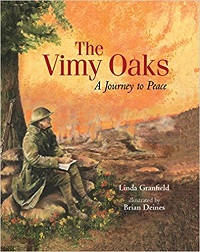| ________________
CM . . .
. Volume XXIII Number . . . .March 17, 2017
excerpt:
Leslie mailed the acorns, tiny bundles of life, to his family in Canada. He could not have imagined then what would result one hundred years later from his pocketful of promise. In telling the story of Leslie Miller and the tiny acorns he picked up on Vimy Ridge in 1917, Linda Granfield poignantly links the lives, character and aspirations of a Canadian War I veteran to the lives of Canada’s newest generation. Twenty five year old Leslie Miller was originally from the small farming community of Milliken, ON, but, when the war began in 1914, he was teaching in Saskatchewan. He went to Winnipeg, enlisted, and in early 1915, he was in England with the Canadian Expeditionary Force (CEF). Leslie was assigned to the Canadian Signal Corps, which had the dangerous job of maintaining communications between headquarters and the officers commanding soldiers in the field. He also kept a personal diary to record his feelings and to comment on what was happening around him. However, as a farm boy, he was also interested in the local plants, flowers and trees, and so he also recorded these observations in his diary. In April 1917, Leslie was fighting along with the rest of the CEF on Vimy Ridge. One day, shortly after the battle, he picked some acorns from the ground and, for some reason, mailed them home to Canada. In 1919, Lieutenant Leslie Miller was discharged from the forces and returned to the Miller’s family farm. He got married and was given 24 acres of the farm. He named his farm Vimy Oaks. He eventually sold the farm, retired and died in 1979. In 2004, a family friend was visiting Vimy Ridge and noticed that there were no oak trees on the famous ridge. They had all been destroyed during the war. He thought, “What if Vimy Ridge could be green again, with oak trees descended from Leslie’s Ontario trees?”. Out of this idea grew the Vimy Oakes Repatriation Project to have oak trees planted across Canada and on Vimy Ridge and at the Vimy Foundation Centennial Park near the Canadian National Vimy Memorial. Granfield has included many excellent pictures of Leslie when he was a soldier during the Great War and on his farm in Ontario. There are also images of Vimy Ridge during the war, what it looked like when the National Memorial was being built, and what it looks like today. Brian Deines oil on canvas illustrations deftly capture not only Leslie’s contemplative mood while writing in his diary, but also his life in the trenches and on the farm. The fighting in the trenches was only one part of the lives of Canada’s World War l soldiers. There are many, many evocative stories that bring out the often forgotten or ignored character, humanity and aspirations of these men and women. Granfield has brought readers one of these, and she is to be commended by all Canadians. Note that the complete service records of Leslie Howard Miller # 81593 can be found in the Personnel Records of the First World War Database at Library and Archives Canada www.bac-lac.gc.ca Highly Recommended. Now that he is retired from teaching, Ian Stewart has taken on the role of curator at the Royal Winnipeg Rifles Museum and Archives in Winnipeg, MB.
To comment
on this title or this review, send mail to cm@umanitoba.ca.
Copyright © the Manitoba Library Association. Reproduction for personal
use is permitted only if this copyright notice is maintained. Any
other reproduction is prohibited without permission.
Next Review | Table of Contents For This Issue - March 17, 2017 |
